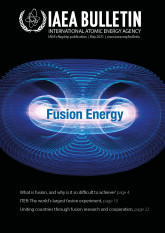
If you would like to learn more about the IAEA’s work, sign up for our weekly updates containing our most important news, multimedia and more.
How IAEA Databases Help Advance Research Towards the Commercial Use of Fusion
Peeva, Aleksandra

A visualization of the cascade of collisions leading to damage in a crystalline material. (Image: courtesy of Andrea Sand, University of Helsinki)
The promise of harnessing nuclear fusion’s abundant energy potential through commercial fusion requires a better understanding of plasmas — superheated ionized gases — and the development of high-performance reactor materials. By supporting scientists studying plasma behaviour, and modelling the properties of materials used in fusion energy research, IAEA databases are helping to advance research towards eventual energy production on a commercial scale.
Central to developing fusion energy is achieving and then maintaining the extreme conditions needed for ‘fusion ignition’ — the point at which a fusion reaction is sustained by its own generated energy. This requires the reaction’s plasma fuels to be confined in a space for long enough to allow fusion to develop and heat itself to self-sufficiency.
Ignition also requires engineers to develop high-performance reactor wall materials able to withstand the steady flux of energy in the form of released heat and neutrons. This energy heats up the walls, and the neutron bombardment can lead to material damage — compromising the integrity of the wall material or causing the material to sputter back into the plasma and cool it.
A reactor’s materials should also absorb as little tritium — one of the hydrogen isotopes of the fusion’s fuel — as possible. Absorbed tritium fuel is lost fuel for the reaction. But more importantly, tritium is radioactive, and to minimize the amount and radiotoxicity of the eventual nuclear waste generated, the reactor’s walls should ideally not absorb tritium and become radioactive in the process.
“ Only with reliable data from accurate computation and experiments can the relevant properties of candidate materials be predicted.
Exploring plasma behaviour
A deep understanding of how plasma behaves in a reactor is necessary to increase the length of time it can be confined by magnetic forces. IAEA databases hold information on the processes occurring in core plasma and edge plasma, as well as in neutral beam injection systems used to heat the plasma towards ignition. They also contain data on the properties of various impurities that are deliberately injected into the plasma for diagnostic purposes and to mitigate instabilities.
The IAEA’s ALADDIN database is a searchable repository of evaluated collisional data for fusion-relevant processes. It is used by the research community to perform plasma diagnostics and learn about important plasma parameters, such as temperature and density. Using ALADDIN, scientists can better understand the collisional–radiative properties of ions that are critical for reliable plasma diagnostics.
Modelling materials for fusion
A lack of facilities that replicate the extreme conditions of a fusion reactor makes creating new materials for future fusion power plants complex. Using computational modelling techniques, high-performance computing platforms and analytical experimental characterization tools, experts are able to design materials that can perform well in a fusion energy environment.
Through modelling, new materials are being discovered and the reliability of existing materials can be predicted. This is especially important for the reactor’s innermost wall, which is located closest to the plasma in the reactor vessel and protects the vessel components from plasma-induced damage.
“The extreme environment of a nuclear fusion reactor’s first wall demands a careful choice of materials which must withstand high temperatures and particle bombardment without becoming eroded, brittle or radioactive, and without retaining the hydrogen fuel,” said Christian Hill, Head of the IAEA’s Atomic and Molecular Data Unit. “Only with reliable data from accurate computation and experiments can the relevant properties of candidate materials be predicted.”
Researchers use IAEA databases in fusion energy research and other plasma science and technology applications. Data are collected and evaluated by the IAEA through its networks, coordinated research projects and Technical Meetings, and distributed through its free, searchable and curated online databases.
“The value in a curated, international database is in its role as a permanent, trusted and accessible repository of evaluated data that can be freely used by the fusion community. The IAEA’s Atomic and Molecular Data Unit is unique in other ways, too: it has existed for more than 40 years, which is pretty old in ‘fusion-data years’,” said Hill.
The IAEA’s databases are continuously improved and expanded based on the specific data needs of researchers — the quantification and implication of uncertainties in data, and techniques for data validation, curation and dissemination.
All fusion-related databases maintained by the IAEA can be accessed here.





